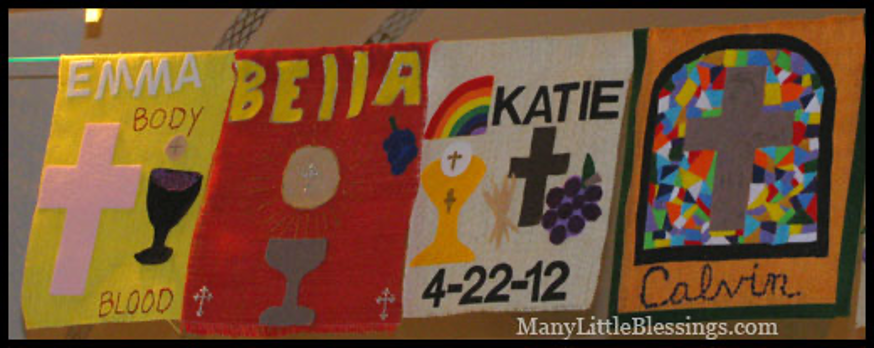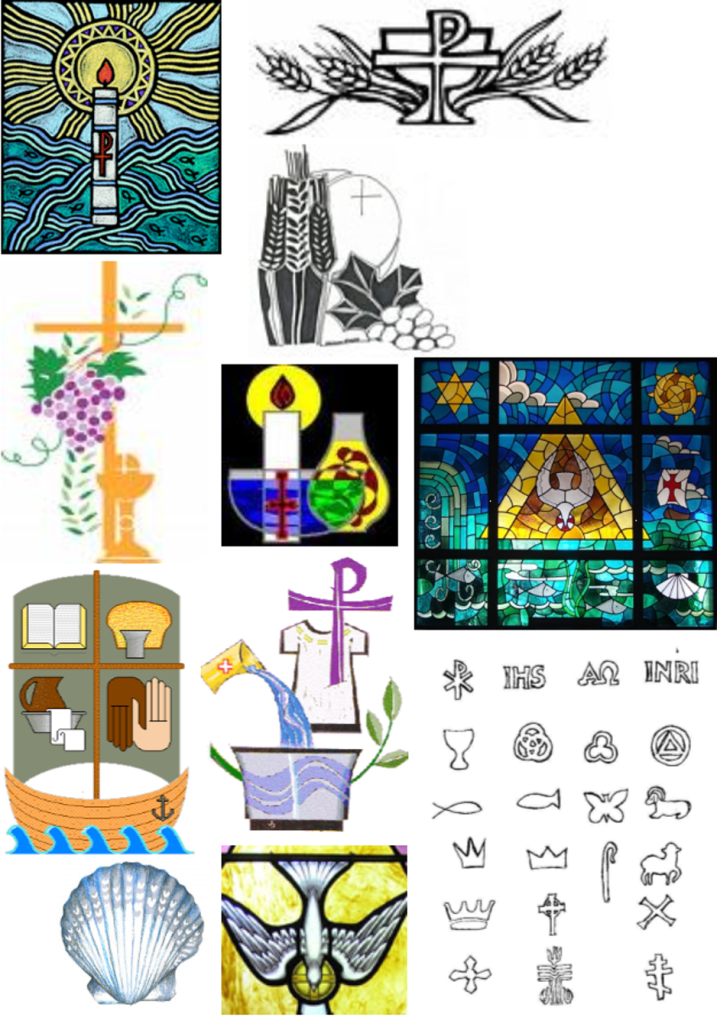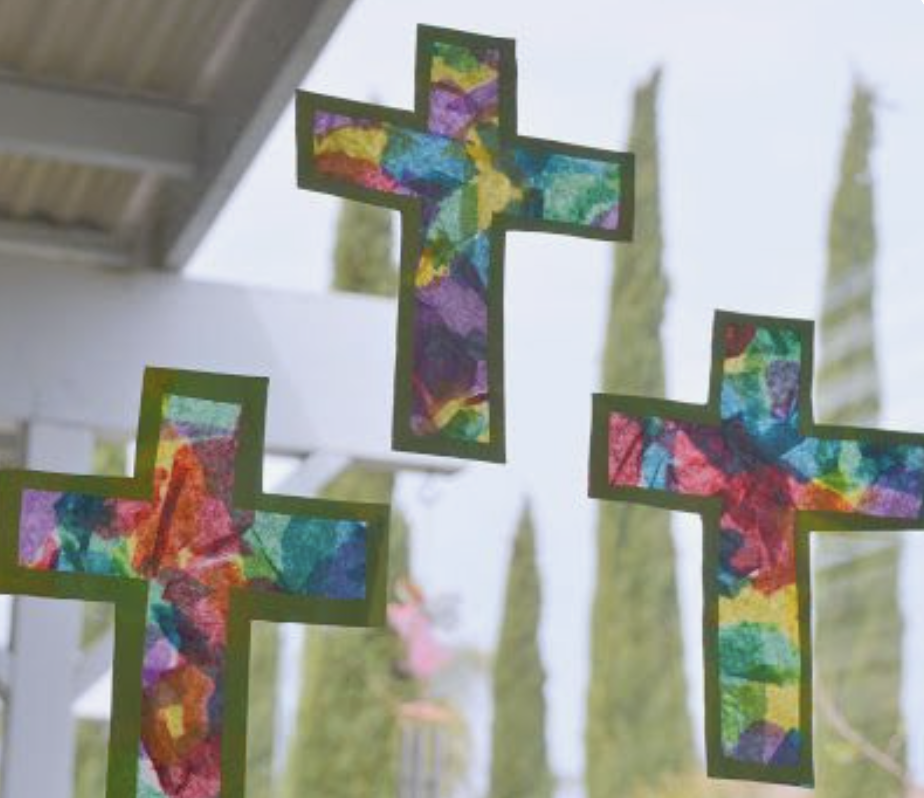In an effort to share materials that are used in our preparation for this blessed sacrament, we have created this area to hold documents and instructions that will support our lessons. If you are interested in our program and your child is not currently attending a Catholic School, we would like them and your family to be involved in our Children’s Faith Formation (Growing in Faith Together).
For our 1st communion preparation, we will have three sessions for children and their parents, then an afternoon retreat.
Resources to prepare for the retreat
The Believers Share
42 They spent their time learning the apostles’ teaching. And they continued to share, to break bread,[a] and to pray together.43 The apostles were doing many miracles and signs. And everyone felt great respect for God. 44 All the believers stayed together. They shared everything. 45 They sold their land and the things they owned. Then they divided the money and gave it to those people who needed it. 46 The believers met together in the Temple every day. They all had the same purpose. They broke bread in their homes, happy to share their food with joyful hearts. 47 They praised God, and all the people liked them. More and more people were being saved every day; the Lord was adding those people to the group of believers.
On the Road to Emmaus
13 That same day two of Jesus’ followers were going to a town named Emmaus. It is about seven miles from Jerusalem. 14 They were talking about everything that had happened. 15 While they were discussing these things, Jesus himself came near and began walking with them. 16 (They were not allowed to recognize Jesus.) 17 Then he said, “What are these things you are talking about while you walk?”
The two followers stopped. Their faces were very sad. 18 The one named Cleopas answered, “You must be the only one in Jerusalem who does not know what just happened there.”
19 Jesus said to them, “What are you talking about?”
The followers said, “It is about Jesus of Nazareth. He was a prophet from God to all the people. He said and did many powerful things. 20 Our leaders and the leading priests gave him up to be judged and killed. They nailed him to a cross. 21 But we were hoping that he would free the Jews. It is now the third day since this happened. 22 And today some women among us told us some amazing things. Early this morning they went to the tomb, 23 but they did not find his body there. They came and told us that they had seen a vision of angels. The angels said that Jesus was alive! 24 So some of our group went to the tomb, too. They found it just as the women said, but they did not see Jesus.”
25 Then Jesus said to them, “You are foolish and slow to realize what is true. You should believe everything the prophets said. 26 They said that the Christ must suffer these things before he enters his glory.” 27 Then Jesus began to explain everything that had been written about himself in the Scriptures. He started with Moses, and then he talked about what all the prophets had said about him.
28 They came near the town of Emmaus, and Jesus acted as if he did not plan to stop there. 29 But they begged him, “Stay with us. It is late; it is almost night.” So he went in to stay with them.
30 Jesus sat down with them and took some bread. He gave thanks for the food and divided it. Then he gave it to them. 31 And then, they were allowed to recognize Jesus. But when they saw who he was, he disappeared. 32 They said to each other, “When Jesus talked to us on the road, it felt like a fire burning in us. It was exciting when he explained the true meaning of the Scriptures.”
33 So the two followers got up at once and went back to Jerusalem. There they found the 11 apostles and others gathered. 34 They were saying, “The Lord really has risen from death! He showed himself to Simon.”
35 Then the two followers told what had happened on the road. They talked about how they recognized Jesus when he divided the bread.
Baptismal Promises
P: Our faith must be in God, the all-powerful and loving maker of heaven and earth. Do you all believe in God our Maker?
All: Yes, I believe in God our Maker.P: Our faith must be in Jesus, God’s only Son, who became human like us. He died for love of us, and He has risen again to bring us new life. Do you all believe in Jesus, God’s Son?
All: Yes, I believe in Jesus, God’s Son.P: Our faith must be in the Holy Spirit. By baptism the Holy Spirit has come to live in us. The Spirit brings us together as God’s family. The Spirit helps us to forgive each other and to live in love. Do you all believe in God the Holy Spirit?
All: Yes, I believe in God the Holy Spirit.P: Our faith must be in the power of the Spirit to make us the Church, the people of God, the living Body of Christ. Together we eat this holy meal. Together we must serve each other and the whole world. Do you believe in yourselves, the Church, the People of God?
All: Yes, I believe in the Church, the People of God!
Prayer of the Faithful
Please read these over before the retreat and compose your own petition for a group of people you would like to pray for at your First Communion using the formula provided below.
The “Prayer of the Faithful” or “Universal Prayers” are prayers in which we ask for God’s help for our world, our church and our community families and friends, each other and ourselves. They are also knoewn as “petitions” or “intercessions’ or “intercessory prayer”.
The Prayer of the Faithful is prayed in a particular order, you can think of it as a “V” or a triangle, going from the larger, world community needs to the more local needs:

These prayers are written in a particular format. We often use the “For _____, may _____.” format.
Basically it sounds like; “for those suffering with homelessness , may they find food and shelter.
Each prayer will end with “We pray to the Lord” and the congregation will respond, “Lord, hear our prayer”.
If you are reading Prayer of the Faithful, you should wait until the congregation has responded, “Lord, hear our prayer.” before moving away from the ambo.
Below is a selection of music that will be used at mass for 1st Communion. We recommend listening while you work on your banner or candle designs.
Canticle of the Sun
Open My Eyes Lord
Table of Plenty
You will each receive a tall pillar candle, small bottle of glue and paint brush to decorate your candle for 1st Communion. You are welcome to purchase paints if you would prefer to paint instead of decoupage. Here is a similar type of paint to what we have used in the past.
Decoupage Instructions:
- Cut imagery out of a magazine or colored paper and apply them to the candle by painting glue under and on top of the image.
- Rubbing with a wet paper towel or your fingers will remove any air bubbles between the image and the candle surface.
- Let dry and if desired apply extra coats of glue to the top to further secure and finish the effect.
Be creative and choose a favorite symbol or your name and the date of your First Communion, etc. See sample below of suggested imagery you might consider.

Supply List and Instructions Pew Banners:
- Rectangular piece of felt
- 18-24” section of ribbon of your choice.
- Symbol ideas (feel free to come up with your own symbols for what First Eucharist means for you. You may decorate your banner any way you like, with felt, other fabric, dimensional paints like “Tulip” or “Scribbles” brands or decorations that you can glue or sew on.)
- Piece of cardboard – You may design your banner either horizontally or vertically. Refer to the drawing below to see how to attach the cardboard strip and ribbon to the back of your banner (You can cut the cardboard shorter for a vertical banner). Hot glue, tacky glue or fabric glue work well for attaching the cardboard and ribbon.
You may exchange your felt or ribbon for another color by purchasing your own at a fabric or craft store, it just needs to be the same 9″x 12″ dimensions.
Please make sure your child’s name is on the banner somewhere. We encourage you to let your child do the artwork. Religious symbols and ideas are included, but your child can also use symbols that represent who he or she is, hobbies, sports, etc.



We would also encourage you to use symbols of Christ, the Trinity, or of baptism. Several examples are on the next couple of pages. You can also put the date of your First Eucharist, if you would like.
See sample below of suggested imagery you might consider.

Supply List and Instructions Stained Glass Craft
-Sheet of 8.5×11 or 9×12 clear adhesive paper
-Sharpie or other black permanent marker
-Black and white clipart of First Communion imagery like a chalice and host
-Small pieces of colored tissue paper
Place Black and white clipart image behind the adhesive paper and hold up to a window so that the image shows through the paper backing of the clear sheet
Use the sharpie to trace the image onto the clear adhesive
Put the adhesive sheet face down on a table and peel the paper backing off
Place the small pieces of tissue paper on the back of the image to simulate stained glass
Hang the finished artwork in a window so the light can shine though.

GOALS
- To heighten the child’s awareness of bread in his/her everyday life.
- To introduce bread as a symbol of life and love.
REFLECTION
The celebration of Eucharist is the most powerful experience for Christians in the church. When we join in Eucharist, we are breaking bread and eating together in a feast that unites us with one another and with Christ.
The bread itself abounds with symbolism for us.
Each ingredient has a direct relation to life itself.
YEAST is the life giving element in bread. It allows the bread to grow and expand. The warm environment provided by our family and friends allows us to grow as individuals in much the same way.
FLOUR is the natural ingredient which makes up the substance of the bread. The “flour” in our lives are those natural characteristics that make up our personality. When these are developed it leads us to a rich, full, spiritual life.
MARGARINE, OIL, OR BUTTER is another necessary ingredient in making bread. The lubricating element helps the bread to grow and withstand the pressure of heat when baking. The assurance and approval we receive from our loved ones acts as a lubricating element in our lives.
SALT AND SUGAR add flavor to the bread and add quick nourishment for the yeast. In the same light, special “flavor filled” moments in our lives give us extra energy in our day to day lives.
Bread comes in many forms. It is a necessity for life. As we share bread at Eucharist, we are acknowledging our dependency on God and on others to sustain us.
As parents and educators, how can we heighten the child’s awareness of the importance of daily bread?
- Visit a bakery such as Stone Mill (now called Big Sky) together. Have a simple meal of soup and bread. Let your child pick the kind of bread you will have with your next meal. Invite your child to comment on the taste and texture of the bread.
- Expose your child to a variety of kinds of bread. Talk about the importance of bread for sustaining life. When appropriate, discuss which country relies on a particular bread for its staple food.
How can we heighten the child’s awareness to the significance of bread?
- Bake different kinds of bread together and while baking the bread discuss the individual ingredients and the role each plays in the baking process.
- Leavening such as yeast or baking soda/powder helps the bread expand and grow.
- Flour, a natural ingredient that comes from wheat, enriches the bread and gives it substance.
- Oil helps the bread to grow and withstand the heat when baking.
- Salt and sugar add flavor and nourish the yeast.
- At special meals and celebrations invite your family to share a loaf of bread ceremoniously.
HEAR THE WORD
MARK 6:30-44 MARK 8:1-10
MATT.14:13-21 LUKE 9:10-17
Jesus feeds many people
MARK 14:22-24 MATT. 26:26-28
The institution of the Eucharist
JOHN 6:35 “I am the bread of life”
Bread Baking Recipe/Directions (makes 5 small loaf pans)
Have each child put a name sticker on a lid.
Let the children take turns measuring, pouring and mixing.
Ingredients:
1 c white flour
1 c wheat flour
2 packets of yeast
½ c sugar
1 ½ tsp. salt
1 stick soft margarine
1 ½ cups of very hot wat
2 eggs
Additional 1 ¼ c white flour and 1 ¼ c wheat flour
- Measure out the top 5 ingredients first.
- Mix flour, yeast, sugar and salt into a bowl. Pass the bowl and let each child take a turn stirring briefly with a wooden spoon.
- Add one stick of very soft margarine and let each child stir again.
- Add 1 ½ cups of very hot water then beat with a mixer at medium speed for 2 minutes.
- Add 2 eggs and an additional ½ c white flour and ½ c wheat flour and beat on high for one minute (or until thick and elastic).
- Stir in up to an additional 1 ¼ c white flour and 1 ¼ c wheat flour, a little at a time, until it forms a soft dough which leaves the sides of the bowl as you stir.
- Form the dough into a ball. Knead on a floured board for 5-10 minutes until dough is smooth and elastic.
- Divide the dough into 5 equal parts and have children each put a part into a tin pan with their lid. Allow bread to rise at least 15-20 minutes in a warm place before baking. Bake bread for 35-40 minutes at 350˚.